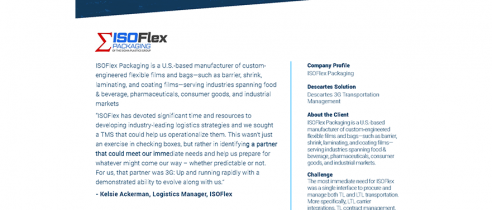Blog
5 TMS Modules to Grow Your Freight Brokerage Fast

The global supply chain management market hit $15.58 billion in 2020 and is expected to reach almost $31 billion by 2026. Accordingly, the worldwide supply chain management software market is also rapidly expanding—and with this fast growth comes new challenges to overcome.
Supply chain freight brokers face issues ranging from labor and warehouse shortages to more basic business challenges like managing dispatch center overhead and maintaining customer relationships.
Technology industry players are turning to meet the increasing complexity in today’s supply chain with modern transportation management systems (TMSs). TMSs can alleviate the pressure that today’s supply chain freight brokers face by:
- Saving time with a streamlined logistics process through automation and better understanding of operations
- Executing essential supply chain operations processes within a single platform rather than a host of single-issue solutions
- Reducing costs across modes and carriers with built-in rate shopping, load consolidation, routing, and freight settlement
Of particular use to supply chain freight brokers are five core TMS modules: analytics and reporting, order management, freight management, transportation, and manufacturing. These modules can be used to help freight brokers grow with the evolving marketplace.
Here’s how.
1. Analytics and Reporting Module
The massive amounts of data generated by today’s brokerages is operational gold by those who know how to harness it. A key advantage of a modern TMS is the analytics, reporting, and dashboards that empower brokerages to take charge of their data. This can be a game-changer, especially for the freight broker upgrading from a manual process or even moving up from a basic TMS without automated analytics and reporting on the brokerage’s data.
A good analytics and reporting TMS module should collect, analyze, and summarize all transportation and supply chain data and metrics for the entire brokerage—then generate relevant reports on everything from expenses and invoicing to performance issues like fuel usage and on-time rates.
Data is gathered from internal and external sources to speed up decision-making and keep every supply chain player in the process informed. Analytics and reporting module portals provide both visibility into operations and enable communication with vendors, carriers, and customers. Work can be managed from a central workspace doing away with cumbersome manual processes and placing critical information like automated freight rate feeds and workflows on one screen.
For customers, analytics and reporting modules deliver 24/7 access to their shipment data and access to automated reports. Internally, analytics allows for informed decisions about the business and its operations, a benefit that reduces time spent on reports and spurs smart decision-making.
The value in analytics and reporting can be enhanced through a cloud-based TMS rather than an on-site installation by warehousing all data in a central location. This provides brokers with real-time visibility into shipments not available through legacy systems, while also ensuring the TMS is automatically updated over the cloud with important maintenance and security updates.
These tools consolidate data from internal systems and external parties and make it easier to identify new opportunities for cost savings, improved profitability, automated processes, and increased efficiency.
2. Order Management Module
The entire supply chain pipeline involves many moving parts and steps, but it all begins at the order. Modern TMSs optimize order management by consolidating data from diverse systems, including inventory databases, vendor databases, and fulfillment systems. This provides visibility into the entire scope of order from placement to fulfillment, and even takes dynamic order changes into account.
An order management TMS module can generate optimal order route plans, manage transportation change demands, coordinate delivery processes with customers, and integrate delivery data into a central system.
Order management within a TMS helps prevent lost, delayed, or damaged orders during fulfillment—and because of the visibility across diverse systems, everyone including clients, managers, and customer service reps can track orders in real-time.
The order management TMS module also improves the customer experience by optimizing the order-to-fulfillment cycle by providing ongoing visibility in the fulfillment process, offering personalization capabilities, and enabling dynamic order changes. If there is a problem with the shipment, integration with customer service is right there in place, giving agents every piece of order information necessary to resolve issues. Automation built into the system might even suggest solutions to help streamline the customer service process.
The order management module improves efficiency throughout the order process by automating key fulfillment elements like generating optimal routing plans, managing changes in transportation or delivery demands, and recording delivery data. Integration across different systems involved in fulfillment reduces mistakes by managing all the information in one place. Simply put, the order management module enables fulfillment leading to higher customer satisfaction and retention.
3. Freight Management Module
Orders may be the backbone of the industry, but freight management is the lifeblood behind fulfilling those orders. Poor freight management leads directly to losses and a bottom-line impact. Between balancing an equation of rising fuel costs, driver shortages, and keeping up with regulation and compliance issues—manual freight management processes simply won’t cut it in today’s complex supply chain.
A TMS freight management module taps into external and internal data sources to predict freight charges, automate invoicing, and streamline settlement issues to save brokerages time and money.
The TMS freight module will collect and analyze data to predict freight costs across different orders and order types. It will include automation to allow carriers to self-invoice to their specific requirements and should include a settlements function for managing invoice issues with carriers.
For example, in the spot market the freight management module can quickly post to load boards, solicit carrier networks for spot bids, review historical lane pricing, and evaluate current market rate conditions. This process is dramatically more efficient than manually managing the spot market.
With automated billing, freight bills falling out of established thresholds are flagged as exceptions for rejection or investigation. Rating and pricing management provides flexibility on pass-through or markup costs and aggressive spot or contract pricing to win new business.
With freight management so central to profit and loss, it is reassuring to know that Gartner research found an average operational cost savings from a TMS between 5% and 15%, along with a productivity gain of 5% to 10%.
4. Transportation Module
The transportation module is the workhorse of the TMS—drilling deep into transportation costs across the supply chain to dramatically improve critical functions like route optimization, mode selection, and carrier utilization.
A TMS transportation module handles core shipping elements, including carrier management, route optimization, increasing efficiency, and cost-savings.
The transportation TMS module will handle route optimization and consolidation and aid trip managers with planning and execution by providing visibility into the routes taken by trucks through fleet tracking. Beyond fleet tracking, it will also handle fleet capacity management. Performance monitoring allows for visibility into fleet efficiency to find and fix bottlenecks.
Carrier management capabilities include improved efficiencies across carrier on-boarding, contract management, carrier assignment and shipment execution. This includes carrier qualification, spot quoting, broadcast and waterfall tendering, and status tracking. For carrier onboarding, the module can connect to DAT, RMIS and similar carrier onboarding and monitoring solutions. This integration minimizes risk and accelerates adding new carriers to the fleet.
Better customer service is facilitated through allowing easy communication between supply chain stakeholders through collaboration tools to address issues around shipments, invoices or any other fulfillment problem that might arise. The transportation module enhances the customer experience by improving customer service.
Ultimately, this leads to increased productivity. When you can process more loads, you can dramatically boost growth with an acceleration that wouldn’t be possible with legacy manual methods.
5. Manufacturing Module
Freight brokerage for manufacturing is a rising sector. Pandemic-created conditions led to domestic manufacturers ramping up output. At the same time, demand has outpaced supply for less than truckload (LTL) capacity, meaning there is opportunity to help manufacturers get products into consumers’ hands.
A TMS manufacturing module is designed to address manufacturing sector pain points and provides freight brokers the opportunity to build integrated TMS networks with manufacturing shippers.
TMS modules specific to the manufacturing sector improve supply chain efficiency overall, and specifically right now directly address an area for OTR freight broker growth.
Features include inventory optimization through inventory control and management and operations management to meet consumer demand and monitor warehouse workforce performance. Making sure products arrive on time provides peace of mind and automated efficiency for the manufacturing industry.
Where the TMS manufacturing module can really shine for brokers navigating the changing LTL marketplace is through capabilities like dynamic pricing based on available carrier capacity and the amount of freight in the system. The real power comes when freight brokers can run a dynamic TMS integrated with carrier and shipper networks.
There is opportunity for freight brokers to create integrated TMS networks with manufacturers to save money and automate planning, while taking into account data like fuel surcharges and intermodal rates. Many manufacturers are manually routing freight. Understanding this approach isn’t efficient they are turning to TMSs creating the integrated TMS network opportunity.
Growth in a Changing Marketplace
A cloud-based, modern TMS offers freight brokerages the ability to meet the challenges of today’s changing and complex supply chain. Together, the five core TMS modules—analytics and reporting, order management, freight management, transportation, and manufacturing— automate and optimize every core function of the freight broker business with new capabilities to make your business more efficient and ready to grow with the market.







